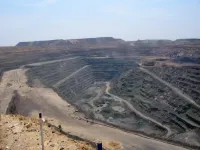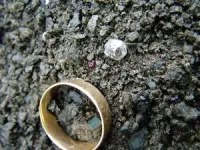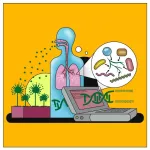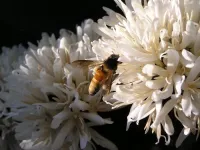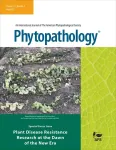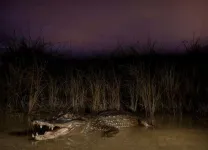(Press-News.org) An international team of scientists led by the University of Southampton has discovered that the breakup of tectonic plates is the main driving force behind the generation and eruption of diamond-rich magmas from deep inside the Earth.
Their findings could shape the future of the diamond exploration industry, informing where diamonds are most likely to be found.
Diamonds, which form under great pressures at depth, are hundreds of millions, or even billions, of years old. They are typically found in a type of volcanic rock known as kimberlite. Kimberlites are found in the oldest, thickest, strongest parts of continents – most notably in South Africa, home to the diamond rush of the late 19th century. But how and why they got to Earth’s surface has, until now, remained a mystery.
The new research examined the effects of global tectonic forces on these volcanic eruptions spanning the last billion years. The findings have been published in the journal Nature.
Southampton researchers collaborated with colleagues from the University of Birmingham, the University of Potsdam, the GFZ German Research Centre for Geosciences, Portland State University, Macquarie University, the University of Leeds, the University of Florence, and Queen’s University, Ontario.
Tom Gernon, Professor of Earth Science and Principal Research Fellow at the University of Southampton, and lead author of the study, said: “The pattern of diamond eruptions is cyclical, mimicking the rhythm of the supercontinents, which assemble and break up in a repeated pattern over time. But previously we didn’t know what process causes diamonds to suddenly erupt, having spent millions – or billions – of years stashed away 150 kilometres beneath the Earth’s surface.”
To address this question, the team used statistical analysis, including machine learning, to forensically examine the link between continental breakup and kimberlite volcanism. The results showed the eruptions of most kimberlite volcanoes occurred 20 to 30 million years after the tectonic breakup of Earth’s continents.
Dr Thea Hincks, Senior Research Fellow at the University of Southampton, said: “Using geospatial analysis, we found that kimberlite eruptions tend to gradually migrate from the continental edges to the interiors over time at rates that are consistent across the continents.”
Geological processes
This discovery prompted the scientists to explore what geological process could drive this pattern. They found that the Earth’s mantle – the convecting layer between the crust and core – is disrupted by rifting (or stretching) of the crust, even thousands of kilometres away.
Dr Stephen Jones, Associate Professor in Earth Systems at the University of Birmingham, and study co-author said: “We found that a domino effect can explain how continental breakup leads to formation of kimberlite magma. During rifting, a small patch of the continental root is disrupted and sinks into the mantle below, triggering a chain of similar flow patterns beneath the nearby continent.”
Dr Sascha Brune, Head of the Geodynamic Modelling Section at GFZ Potsdam, and a co-author on the study, ran simulations to investigate how this process unfolds. He said: “While sweeping along the continental root, these disruptive flows remove a substantial amount of rock, tens of kilometres thick, from the base of the continental plate.”
The typical migration rates estimated in models matched what the scientists observed from kimberlite records.
“Remarkably, this process brings together the necessary ingredients in the right amounts to trigger just enough melting to generate kimberlites,” added Dr Gernon.
The team’s research could be used to identify the possible locations and timings of past volcanic eruptions tied to this process, offering valuable insights that could enable the discovery of diamond deposits in the future.
Professor Gernon, who was recently awarded a major philanthropic grant from the WoodNext Foundation to study the factors contributing to global cooling over time, said the study also sheds light on how processes deep within the Earth control those at the surface: “Breakup not only reorganises the mantle, but may also profoundly impact Earth's surface environment and climate, so diamonds might be just a part of the story."
END
Scientists crack the code of what causes diamonds to erupt
New research could spark future diamond discoveries
2023-08-07
ELSE PRESS RELEASES FROM THIS DATE:
A fungus gets comfortable
2023-08-07
Aspergillus fumigatus strains that infect humans have a significantly altered metabolism compared to other strains in the environment. At the same time, infection with the fungus leads to an apparent change in the human lung microbiome. Researchers at the Leibniz Institute for Natural Product Research and Infection Biology (Leibniz-HKI) in Jena, Germany, came to this conclusion after using machine learning models to analyze genome data from about 250 fungal strains and lung microbiome data from 40 patients.
The fungus Aspergillus fumigatus is widely distributed in the environment, where it performs important ecological functions. ...
CEHD researchers receive funding for project on quantum teaching & learning in elementary classrooms
2023-08-07
Nancy Holincheck, Assistant Professor, Advanced Studies in Teaching and Learning, School of Education; Jessica Rosenberg, Associate Professor, Physics and Astronomy; Stephanie Dodman, Associate Professor, School of Education; and Benjamin Dreyfus, Associate Professor, Physics and Astronomy, received funding from the National Science Foundation for the project: "EAGER: Quantum is Elementary: Quantum Teaching & Learning in Elementary Classrooms."
The researchers will study learning associated with elementary teachers' engagement in professional learning and elementary students' learning related to quantum science, quantum thinking, and careers. The ...
More work needed to unlock mysteries of Asia’s bees
2023-08-07
Although the collapse of hives of European honey bees (Apis mellifera) has gained worldwide attention in recent years, there are massive gaps in knowledge of other bee species, particularly in the Asian region, which contains over half the world’s human population and where food security (in which bees play a key role) remains a major challenge.
According to a recent global analysis, only 1% of the global public data on bee distribution comes from Asia, even though 15% of the world’s bee species are thought to live there.
In a new paper, “Opportunities and challenges in Asian bee research and conservation”, published in the journal ...
Symptoms of the body and the mind are frequent fellow travelers
2023-08-07
INDIANAPOLIS – Chronic pain is often accompanied by depression and anxiety. In an invited commentary published in JAMA Network Open, Kurt Kroenke, M.D., of Regenstrief Institute and Indiana University School of Medicine, discusses the relationship between pain, the most common symptom for which individuals visit a physician, and depression and anxiety, the two most prevalent mental health conditions worldwide. He highlights the importance of not neglecting psychological symptoms in patients experiencing pain.
“One of the reasons for the bi-directional linkage between pain and depression, as well as anxiety, is the existence of a feedback ...
T. Boone Pickens Foundation donates $20 million to Wilmer Eye Institute, Johns Hopkins Medicine
2023-08-07
The T. Boone Pickens Foundation, established by the late, Texan innovative energy leader and philanthropist, is donating $20 million to the Wilmer Eye Institute, Johns Hopkins Medicine. The gift, announced in 2013, is one of the largest research donations in Wilmer’s history. It will fund vision-saving research and a professorship.
Pickens’ interest in the treatment and research of eye conditions developed in the 1980s after his father’s diagnosis of macular degeneration, a progressive condition that disrupts the central field of vision and causes ...
SwRI helps create open-source software to assist rail industry decarbonization efforts
2023-08-07
SAN ANTONIO — August 7, 2023 —Southwest Research Institute is helping the freight rail industry assess potential pathways to decarbonization with a new open-source modeling and simulation software known as ALTRIOS. ALTRIOS, the Advanced Locomotive Technology and Rail Infrastructure Optimization System, can simulate the real-world impacts and expenses related to adopting alternative energy locomotive technologies and expanding associated infrastructure.
Now publicly available for download, ALTRIOS supports several simulation modes to provide rail industry stakeholders with optimal strategies for implementing ...
A promising investigational therapeutic monoclonal antibody to treat chronic hepatitis B and D infections
2023-08-07
Affecting hundreds of millions of people, chronic hepatitis B is a widespread global health problem for which there is as yet no cure. In a preclinical study involving the German Center for Infection Research (DZIF), Heidelberg University Hospital, University Medical Center Hamburg-Eppendorf and the US company Vir Biotechnology, the potential of an engineered investigational human monoclonal antibody for the treatment of chronic hepatitis B and hepatitis D has been demonstrated. Based on the results, clinical trials with the monoclonal antibody VIR-3434 are ongoing.
Chronic hepatitis B ...
Study: People expect others to mirror their own selfishness, generosity
2023-08-07
CHAMPAIGN, Ill. — New research shows that a person’s own behavior is the primary driver of how they treat others during brief, zero-sum-game competitions. Generous people tend to reward generous behavior and selfish individuals often punish generosity and reward selfishness – even when it costs them personally. The study found that an individual’s own generous or selfish deeds carry more weight than the attitudes and behaviors of others.
The findings are reported in the journal Cognitive Science.
Previous research into this arena of human behavior suggested that social norms are the primary factor guiding a person’s decision-making in competitive scenarios, ...
Gene grants powerful resistance to resurging plant disease
2023-08-07
While wrapping oneself in 100% Egyptian cotton bedsheets is a delightful luxury on a warm summer night, cotton provides much more than breathable, soft fabric. In addition to textiles, the cotton plant is grown for food, fuel, and daily-use consumer products—such as coffee filters, currency, and moisturizers. However, a resurging plant disease called bacterial blight is currently threatening cotton production worldwide.
Bacterial blight is best controlled through natural, genetic resistance. ...
Study reveals successful strategies for removing invasive caimans from Florida Everglades
2023-08-07
The spectacled caiman, a species native to Central and South America, has been established in Florida since the 1970s. The pet trade and crocodilian farming industries, escapes and deliberate releases made it possible for caimans to invade the Florida Everglades.
They pose a threat to native wildlife occupying the same habitat as our native alligators and crocodiles, competing for food and other resources. Meanwhile, they also prey upon birds, small mammals, fish and other reptiles.
In a new University of Florida study, published in the journal Management of Biological Invasions, wildlife ...
LAST 30 PRESS RELEASES:
Numbers in our sights affect how we perceive space
SIMJ announces global collaborative book project in commemoration of its 75th anniversary
Air pollution exposure and birth weight
Obstructive sleep apnea risk and mental health conditions among older adults
How talking slows eye movements behind the wheel
The Ceramic Society of Japan’s Oxoate Ceramics Research Association launches new international book project
Heart-brain connection: international study reveals the role of the vagus nerve in keeping the heart young
Researchers identify Rb1 as a predictive biomarker for a new therapeutic strategy in some breast cancers
Survey reveals ethical gaps slowing AI adoption in pediatric surgery
Stimulant ADHD medications work differently than thought
AI overestimates how smart people are, according to HSE economists
HSE researchers create genome-wide map of quadruplexes
Scientists boost cell "powerhouses" to burn more calories
Automatic label checking: The missing step in making reliable medical AI
Low daily alcohol intake linked to 50% heightened mouth cancer risk in India
American Meteorological Society announces Rick Spinrad as 2026 President-Elect
Biomass-based carbon capture spotlighted in newly released global climate webinar recording
Illuminating invisible nano pollutants: advanced bioimaging tracks the full journey of emerging nanoscale contaminants in living systems
How does age affect recovery from spinal cord injury?
Novel AI tool offers prognosis for patients with head and neck cancer
Fathers’ microplastic exposure tied to their children’s metabolic problems
Research validates laboratory model for studying high-grade serous ovarian cancer
SIR 2026 delivers transformative breakthroughs in minimally invasive medicine to improve patient care
Stem Cell Reports most downloaded papers of 2025 highlight the breadth and impact of stem cell research
Oxford-led study estimates NHS spends around 3% of its primary and secondary care budget on the health impacts of heat and cold in England
A researcher’s long quest leads to a smart composite breakthrough
Urban wild bees act as “microbial sensors” of city health.
New study finds where you live affects recovery after a hip fracture
Forecasting the impact of fully automated vehicle adoption on US road traffic injuries
Alcohol-related hospitalizations from 2016 to 2022
[Press-News.org] Scientists crack the code of what causes diamonds to eruptNew research could spark future diamond discoveries
